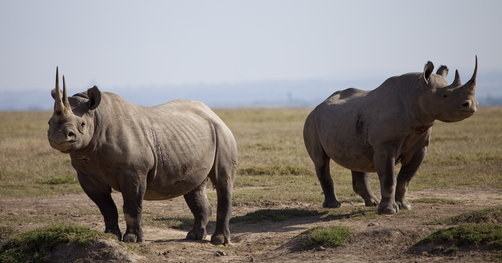Watch those poachers, big rhinoceros.
- Rhinoceros are herbivorous mammals from the family Rhinocerotidae and is a group of five species.
- The word ‘Rhinoceros’ can be shortened to ‘rhinos’, and ‘rhinoceroses’ can also be used as a plural.
- Two rhinoceros, the ‘black’ and the ‘white’, are native to Africa and three, the ‘Indian’, the ‘Javan’ and the ‘Sumatran’ are native to Asia.
- Rhinoceros have chunky skin, 1.5 to 5 centimetre (0.6 to 2 inches) thick, and one or two horns up to 1.5 metres (5 feet) in length that are made of keratin.
- Rhinoceros are common targets for poachers, humans being their only predators, as their horns are considered as valuable as gold on the black market, and are used for ornamental and traditional medicine purposes.
Rhinos
Image courtesy of National Geographic
- ‘Rhinoceros’ is derived from the Ancient Greek words ‘rhino’ and ‘keras’, which mean ‘nose’ and ‘horn’ respectively.
- Rhinoceros can weigh up to and beyond 3,500 kilograms (7,700 pounds) and can run at speeds of 48 kilometres/hour (30 miles/hour).
- Rhinoceros have bad sight but have good hearing and smelling senses and can live up to 35 to 40 years in the wild.
- Rhinoceros range from being ‘near threatened’ to ‘critically endangered’, with less than 70 of the Javan species of rhino alive.
- Rhinoceros are the second largest land mammals alive and range from 2.4 – 4.6 metres (7 ft 10 in – 15 ft) in length and can be as tall as a human, depending on the species.
Bibliography:
Rhinoceros, 2013, Wikipedia, http://en.wikipedia.org/wiki/Rhinoceros
Rhinoceros Rhincerotidae, n.d, Kids Planet, http://www.kidsplanet.org/factsheets/rhinoceros.html







